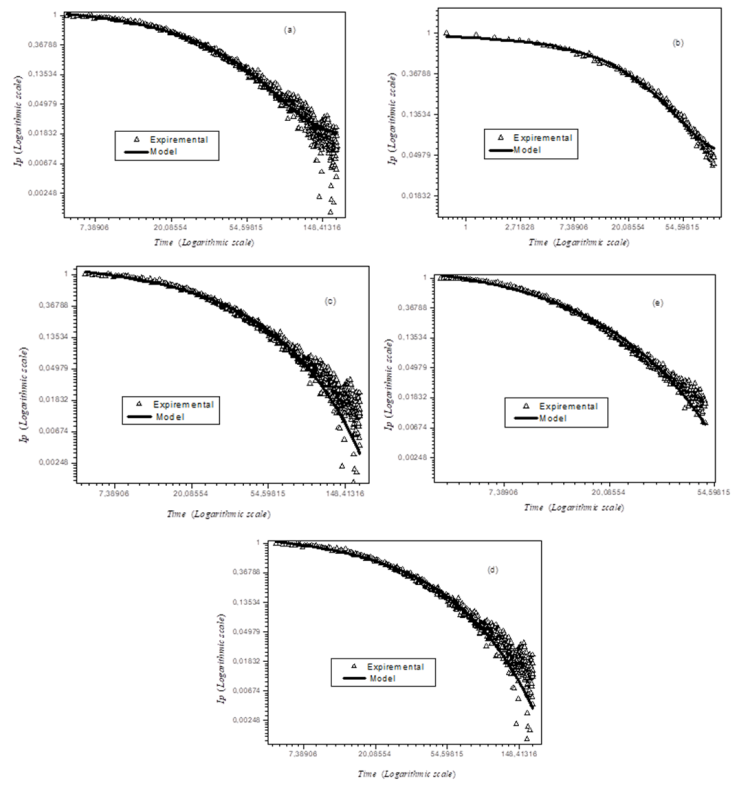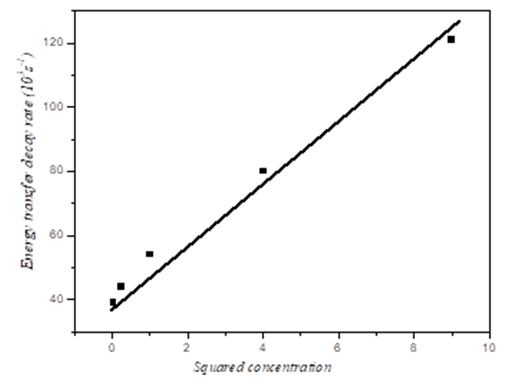-
Paper Information
- Paper Submission
-
Journal Information
- About This Journal
- Editorial Board
- Current Issue
- Archive
- Author Guidelines
- Contact Us
International Journal of Optics and Applications
p-ISSN: 2168-5053 e-ISSN: 2168-5061
2019; 8(1): 8-11
doi:10.5923/j.optics.20190801.02

Stretched-exponential Decay of the Luminescence in Er3+-doped Te2-ZnO Glasses
Abdelfatteh Cherif1, 2, Sami Youssef1
1Common First Year Deanship, UMM Al-Qura University, Saudi Arabia
2Institut Préparatoire aux Etudes d'Ingénieurs de Kairouan, Université de Kairouan, Tunisie
Correspondence to: Abdelfatteh Cherif, Common First Year Deanship, UMM Al-Qura University, Saudi Arabia.
| Email: |  |
Copyright © 2019 The Author(s). Published by Scientific & Academic Publishing.
This work is licensed under the Creative Commons Attribution International License (CC BY).
http://creativecommons.org/licenses/by/4.0/

We present a time-resolved emission decay curves for 4S3/2à4I15/2 transition in Er3+- doped zinc tellurite glass, with the aim to interpret non-exponential decay. PL results can be described by the stretched exponential function. In this study, we address that this function enables us to a multi-configurational distribution of luminescent ions in a disordered medium.
Keywords: Energy Transfer, Decay Time, Erbium
Cite this paper: Abdelfatteh Cherif, Sami Youssef, Stretched-exponential Decay of the Luminescence in Er3+-doped Te2-ZnO Glasses, International Journal of Optics and Applications, Vol. 8 No. 1, 2019, pp. 8-11. doi: 10.5923/j.optics.20190801.02.
1. Introduction
- The analysis of complex luminescence decays explained the dynamics of recombination center yields. The relaxation of different physical systems has been found to follow the stretched-exponential law. In particular, the photoluminescence from glassy materials and other solids [1-3] have been reported in the literature to behave this way. In this paper we present the fluorescence decay profiles of 4S3/2à4I15/2 transition in Er3+- doped zinc tellurite glass (TZG) at various doping concentrations between 0.2 and 3% (molar). We show that the fluorescence decay profile can be fitted with the stretched exponential function. We have explained that lattice defect sites may interact through a dipolar energy transfer mechanism [4-7].
2. Experimental Details
- Glasses were prepared from oxide powders of TeO2, ZnO and Er2O3 as starting materials using the conventional melt-quenching method. The material used in our measurement has a composition of 70TeO2–30ZnO. The amount of dopant was varied between 0.2 and 3 mol% Er2O3. The intrinsic lifetimes of the levels were obtained by exciting the samples with a laser analytical systems dye laser pumped by a pulsed frequency doubled Nd: YAG laser from BM Industries. The duration of pulses was 8 ns. The emitted light has been focused on a Jobin–Yvon HR S2 spectrophotometer. The detection has been performed using an R 1767 Hammamatsu photomultiplier and a Lecroy 9410 averager oscilloscope. All experiments were performed at room temperature.
3. Results and Discussion
- The luminescence decay of homogeneously doped TeO2-ZnO: Er3+ was non-exponential due to non radiative energy transfer processes. Analysis of the photoluminescence decay profiles of Er3+ showed that the energy transfer between Er3+ ions was active only for concentrations beyond 0.5 mol%. We have investigated the luminescence decay of the 4S3/2à4I15/2 transition in order to analyze the dynamics of this energy transfer. Figure 1 depicts the photoluminescence decay profiles of Er3+, measured for different ion concentrations. The luminescence decay was strongly non-exponential with ion concentration dependent time constant. We have found that the rapid decay of the relaxation curve increases with ion concentrations. It is shown that the experimental results of the photoluminescence decay can be described by the stretched exponential function:
 | (1) |
 is an effective time constant and β is a constant between 0 to 1.For values β < 1 the decay is slower than the comparable exponential decay with the same
is an effective time constant and β is a constant between 0 to 1.For values β < 1 the decay is slower than the comparable exponential decay with the same  factor.
factor. | Figure 1. Stretched exponential fit to the decay from the 4S3/2 level of the TZG, under 550 nm pumping |
 | Figure 2. The normalized intensity of the photoluminescence versus the normalized time, for 0.2 (a), 0.5(b), 1(c), 2(d) and 3(e) mol% Er3+ concentration |
 , obtained from the fit of photoluminescence decay data with use of equation 1 (in Figure 2). The parameters obtained from stretched exponential fits to the photoluminescence decay from the 4S3/2 level of the zinc tellurite glass samples are listed in Table 1, for different Er3+ ion concentrations ranging from 0.2 to 3 mol %. The function shows decreasing values of β with increasing concentration of Er3+. The stretched exponential spans the largest dynamic range of β (from 0.995 to 0.941). For the 0.2 mol % ion concentration, the stretched exponential function was very similar to the single exponential results with value of very close to one (0.995). This implies that there is one radiative recombination pathway for excited ions. This proposal is supported by the fact that energy transfer between excited ions can be ignored in the case of a low ion concentration [8]. In the following, we assume that the dominant radiative and multiphonon decay times component reflect the total decay time, and obtain
, obtained from the fit of photoluminescence decay data with use of equation 1 (in Figure 2). The parameters obtained from stretched exponential fits to the photoluminescence decay from the 4S3/2 level of the zinc tellurite glass samples are listed in Table 1, for different Er3+ ion concentrations ranging from 0.2 to 3 mol %. The function shows decreasing values of β with increasing concentration of Er3+. The stretched exponential spans the largest dynamic range of β (from 0.995 to 0.941). For the 0.2 mol % ion concentration, the stretched exponential function was very similar to the single exponential results with value of very close to one (0.995). This implies that there is one radiative recombination pathway for excited ions. This proposal is supported by the fact that energy transfer between excited ions can be ignored in the case of a low ion concentration [8]. In the following, we assume that the dominant radiative and multiphonon decay times component reflect the total decay time, and obtain  from the relation:
from the relation: | (2) |
 is the radiative lifetime of the emitting level 4S3/2 and
is the radiative lifetime of the emitting level 4S3/2 and  is the multiphonon lifetime. To evaluate the first decay time, the intensity parameters
is the multiphonon lifetime. To evaluate the first decay time, the intensity parameters  have been calculated using the Judd-Ofelt formulae [9,10]. The obtained value for this lifetime is 203 µs with use of Ω2 = 1.15, Ω4 = 4.59 and Ω6 = 2.70
have been calculated using the Judd-Ofelt formulae [9,10]. The obtained value for this lifetime is 203 µs with use of Ω2 = 1.15, Ω4 = 4.59 and Ω6 = 2.70 10-20 cm2 respectively. The lifetime
10-20 cm2 respectively. The lifetime  has been computed using the model of multiphonon relaxation proposed by Riseberg and Moos [11] and for which this decay time is given by the relationship:
has been computed using the model of multiphonon relaxation proposed by Riseberg and Moos [11] and for which this decay time is given by the relationship: | (3) |
 and
and  are non-radiative parameters which depend on the host material,
are non-radiative parameters which depend on the host material,  represents the energy gap between two successive levels and
represents the energy gap between two successive levels and  is the number of phonons emitted in the relaxation process. In the case of the 4S3/2-4I15/2 transition, the value of
is the number of phonons emitted in the relaxation process. In the case of the 4S3/2-4I15/2 transition, the value of  , calculated from Eq. (3) at T=300 K, is of magnitude 1.55
, calculated from Eq. (3) at T=300 K, is of magnitude 1.55 103 s. The parameters used for this calculation are:
103 s. The parameters used for this calculation are:  = 7400 cm-1,
= 7400 cm-1,  = 4.7
= 4.7 10-3 cm,
10-3 cm,  = 6.3
= 6.3 1011 and
1011 and  ≈ 750 cm-1 respectively [12]. We will, now, study the effects of the Er3+ ion concentration on the total decay time
≈ 750 cm-1 respectively [12]. We will, now, study the effects of the Er3+ ion concentration on the total decay time  . When this concentration increases, the energy transfer takes place. Thus the decay time characterizing this process must be considered in the calculation of
. When this concentration increases, the energy transfer takes place. Thus the decay time characterizing this process must be considered in the calculation of  . We labeled this decay time
. We labeled this decay time  . Then, Eq. (3) will be rewritten as:
. Then, Eq. (3) will be rewritten as: | (4) |
 from the photoluminescence intensity measurements.
from the photoluminescence intensity measurements. | (5) |
 | (6) |
 | (7) |
 | Figure 3. The decay rate as a function of the square of the Er3+ ion concentration |
|
4. Conclusions
- A model of nonexponential behaviour is considered from the point of view of contribution of dipole-dipole interactions. We may conclude that the dipolar interaction dominates the energy transfer in this system and the incorporation of rare earth ions is made difficult by the structure of the network.With this in mind, the reduction in stretched exponential power observed with the increase in the Er3+ concentration, may indicate that the energy transfer processes affect the decay dynamics of this level for Er3+ concentrations.
 Abstract
Abstract Reference
Reference Full-Text PDF
Full-Text PDF Full-text HTML
Full-text HTML